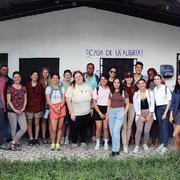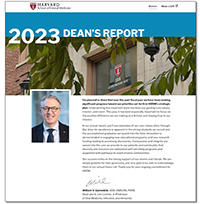
When learning is immersive, you need to be a sponge—particularly when the average daily rainfall in your learning environment is measured in buckets rather than inches. Seven Harvard College undergraduates, four Harvard School of Dental Medicine (HSDM) dental students, and four University of Costa Rica dental students spent their spring break in rural southern Costa Rica for a weeklong field course. Despite unusually rainy weather, a shared interest in global health brought them together to study healthcare systems and left them energized with new perspectives on global health challenges.
“When you’re learning about other healthcare systems it’s hard to get a sense of what it is like for the average person because you’re learning from a book or a website. This was an opportunity to go into the field and learn firsthand about how things work,” Aisha Oshilaja, DMD24, said.
 The experience, which is offered through associate professor of Oral Health Policy and Epidemiology Dr. Brittany Seymour’s Global Oral Health course, provides a chance to see innovative health systems and solutions in action. This is the first year the field course has returned since the onset of the pandemic, and it was expanded to include Harvard College students.
The experience, which is offered through associate professor of Oral Health Policy and Epidemiology Dr. Brittany Seymour’s Global Oral Health course, provides a chance to see innovative health systems and solutions in action. This is the first year the field course has returned since the onset of the pandemic, and it was expanded to include Harvard College students.
“Students arrive with a foundational knowledge in global health from what they’ve learned in the classroom. This field course offers them a chance to spend the week listening, observing, and learning from our community partners here in Costa Rica,” Seymour said. “It makes us all better listeners for our own patients, and better advocates for our own communities.”
Home base for the week is Las Cruces Biological Research Station, deep within the tropical forest in Coto Brus, an area that attracts scientists and researchers from around the world. The location is an ideal spot for students to learn about key challenges in the field of global health: achieving universal health care, environmental degradation, migrations and the demographic, nutritional, and epidemiological transition.
“The environment provides a natural backdrop for students’ brains to begin absorbing everything that happens. It heightens the level of porosity,” said Dr. Carlos Faerron Guzman, director of the Inter-American Center for Global Health, who co-leads the course. “New sounds, smells, tastes—everything is new. It tells them, ‘I need to be a sponge.’ It allows them to learn in a different way that cannot happen in a sterile environment.”
 Each day a different health topic is introduced and followed by a field visit to see health systems in action. The approach allows students to observe how social, political, cultural, behavioral, and economic forces influence health access, health outcomes, and health systems.
Each day a different health topic is introduced and followed by a field visit to see health systems in action. The approach allows students to observe how social, political, cultural, behavioral, and economic forces influence health access, health outcomes, and health systems.
“A typical day starts with an introductory conversation on global health. Then we attach a concept with a site visit that allows students to take that concept to reality. What we want them to do is to take back skills and knowledge and different perceptions of their own values,” Faerron Guzman said.
As part of its universal healthcare system, Costa Rica has a federally supported equipo básico de atención integral en salud or EBAIS system where multi-disciplinary primary care teams are integrated within local communities. EBAIS care teams, and community-based hospitals, often include a dentist and provide dental care onsite.
“Integrating a dental office into the hospital is something that looks so simple but it’s not easy, said Bana Almoussa a pre-med Harvard College junior and neuroscience major. “Oral health is so important. As a physician in the future, I will advocate for making sure oral health is included in my practice.”
On field visits to a local EBAIS, as well as a hospital in San Vito, students had the chance to hear from dentists who serve the community.
 “Here, dentistry is seen as similar to medicine, and in every EBAIS there is a physician and a dentist. It promotes the idea that oral health is a part of systemic health, and you can’t really be healthy while you have oral disease,” Oshilaja said.
“Here, dentistry is seen as similar to medicine, and in every EBAIS there is a physician and a dentist. It promotes the idea that oral health is a part of systemic health, and you can’t really be healthy while you have oral disease,” Oshilaja said.
Another field visit brought students to the border between Panama and Costa Rica to walk the path migrants take into the country and learn about trans-border challenges, and migration and health. Afterward students visited a coffee farm, or finca, to observe the living conditions and childcare challenges for migrant workers who come to the region during the coffee harvest. While conditions vary from one coffee farm to another, some are employing creative practices to discourage child labor.
“The coffee farm that we visited had a house, Casa De La Alegria, a place where children could come to play, to learn, to get an education, while their parents harvested coffee beans. It was an example of putting aside economic gain for humanity,” Almoussa said.
 The Coto Brus area is home to an indigenous population of roughly 3,000 individuals. Students visited La Casona, a community in the Ngäbe-Buglé indigenous territory to see how native traditions have been incorporated into the design and delivery of healthcare.
The Coto Brus area is home to an indigenous population of roughly 3,000 individuals. Students visited La Casona, a community in the Ngäbe-Buglé indigenous territory to see how native traditions have been incorporated into the design and delivery of healthcare.
“A big theme this week has been interculturality and how we can approach different community groups from their perspective,” said Chris Ma, DMD23. “By partnering with the community, they were able to build a space that was welcoming, not only in the physical design, but the staffing. They were able to tailor the space so that ultimately health outcomes are better, and it improves the wellbeing of the people.”
The colors and design of the EBAIS buildings incorporate indigenous patterns, and a large painted mural of an indigenous family adorns the dental clinic. A community health worker from the indigenous community is a trusted member of the care team.
In addition to learning from the course and field visits, the students learned from each other.
“There were a lot of student populations—dental students and Harvard College students from different class years—who were part of this trip. It was unique in contributing to the atmosphere and the kinds of conversations we were having. This experience helped me expand my mind and my thinking,” said Kareem King, a pre-med senior at Harvard College.
 The impact of the course was felt not only by the students but by the faculty too.
The impact of the course was felt not only by the students but by the faculty too.
“They don’t leave the same. This immersive experience emboldens them,” said Seymour. “Our students leave feeling like, ‘I can do this too.’”
“I will never forget this experience,” said Dahee Chung, DMD24, a third-year dental student. “As an oral health professional, I learned there are very different perspectives to approach global oral health and I learned a lot of different strategies and creative ways to improve people’s wellbeing, including oral health. I want to apply what I’ve learned here to my local community, and to global communities that I will meet as a healthcare professional.”
Watch a video about the students' experience:



